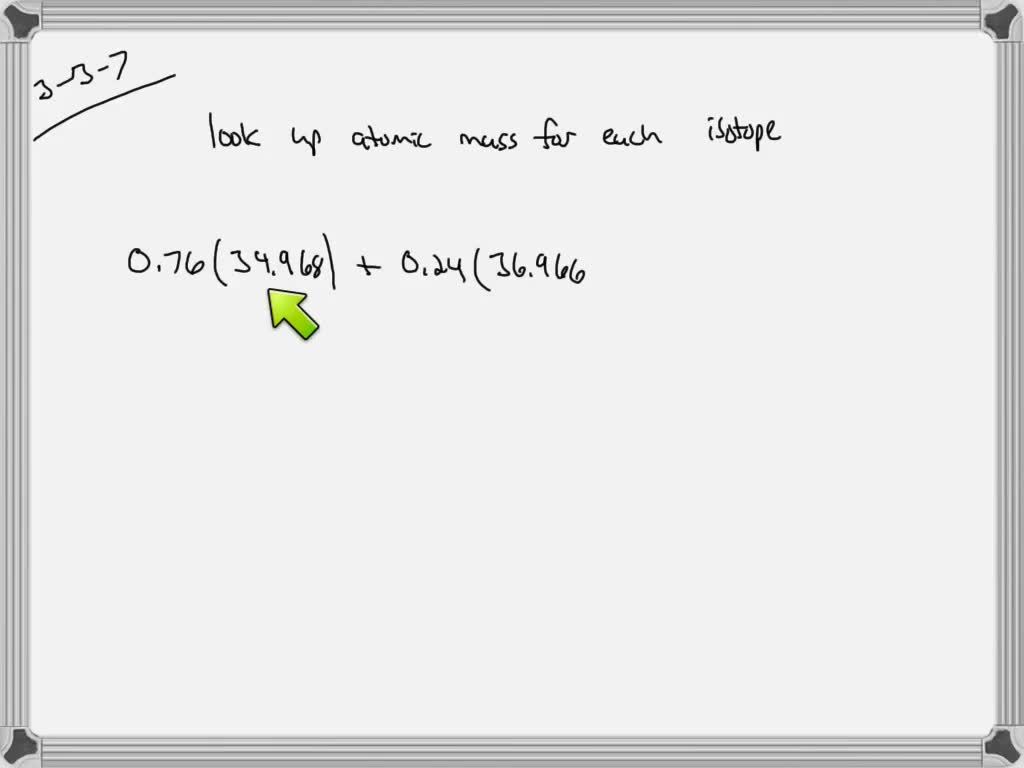2.4 Atomic Weights
Average atomic mass of chlorine = (0.7577 ⋅⋅ 35 amu) + (0.2423 ⋅⋅ 37 amu) = 35.48 amu Another example is to calculate the atomic mass of boron (B), which has two isotopes: B-10 with 19.9% natural abundance, and B-11 with 80.1% abundance.
The atomic masses of Cl-35 (75.53 percent) and Cl-37 (24.47 percent) are 34.968 amu and 36.956 amu, respectively. Calculate the average atomic mass of chlori. Chlorine -35 is about 3 times more abundant than chlorine – 37, the weighted average is closer to 35 than 37. The mass spectrum of Chlorine. Chlorine is such an element which contain more than one atom per molecule. It has two isotopes Cl-35 and Cl-37, so it contain 3 atoms of Cl-35 and 1 atom of Cl-37. In any sample of chlorine atoms, 75.771% will be chlorine-35 and 24.229% will be chlorine 37. Calculate the average atomic mass of chlorine. Copper has two isotopes. Copper-63, which has an atomic mass of 62.93 u and copper-65, which has an atomic mass of 64.93 u. In any sample of copper atoms, 69.1% will be copper-63 and 30.9% will be.


Atoms are small pieces of matter, so they have mass. As noted in Section 2.1, a key postulate of Dalton's atomic theory is that mass is conserved during chemical reactions. Much of what we know about chemical reactions and the behavior of substances, therefore, has been derived by accurate measurements of the masses of atoms and molecules (and macroscopic collections of atoms and molecules) that are undergoing change. Chances are that you are already using mass measurements in the laboratory portion of your course in order to monitor changes that occur in chemical reactions. In this section we will discuss the mass scale that is used for atoms and introduce the concept of atomic weights. In Section 3.3 we will extend these concepts to show how these atomic masses are used to determine the masses of compounds and molecular weights.
The Atomic Mass Scale
Although scientists of the nineteenth century knew nothing about subatomic particles, they were aware that atoms of different elements have different masses. They found, for example, that each 100.0 g of water contains 11.1 g of hydrogen and 88.9 g of oxygen. Thus, water contains times as much oxygen, by mass, as hydrogen. Once scientists understood that water contains two hydrogen atoms for each oxygen, they concluded that an oxygen atom must have times as much mass as a hydrogen atom. Hydrogen, the lightest atom, was arbitrarily assigned a relative mass of 1 (no units), and atomic masses of other elements were at first determined relative to this value. Thus, oxygen was assigned an atomic mass of 16.
Today we can determine the masses of individual atoms with a high degree of accuracy. For example, we know that the atom has a mass of g and the atom has a mass of g. As we noted in Section 2.3, it is convenient to use the atomic mass unit (amu) when dealing with these extremely small masses:
The amu is presently defined by assigning a mass of exactly 12 amu to an atom of the isotope of carbon. In these units the mass of the nuclide is 1.0078 amu and that of the nuclide is 15.9949 amu.
2.4 Atomic Weights

Use dmg in virtualbox. Atoms are small pieces of matter, so they have mass. As noted in Section 2.1, a key postulate of Dalton's atomic theory is that mass is conserved during chemical reactions. Much of what we know about chemical reactions and the behavior of substances, therefore, has been derived by accurate measurements of the masses of atoms and molecules (and macroscopic collections of atoms and molecules) that are undergoing change. Chances are that you are already using mass measurements in the laboratory portion of your course in order to monitor changes that occur in chemical reactions. In this section we will discuss the mass scale that is used for atoms and introduce the concept of atomic weights. In Section 3.3 we will extend these concepts to show how these atomic masses are used to determine the masses of compounds and molecular weights.
The Atomic Mass Scale
Atomic Weight Formula
Although scientists of the nineteenth century knew nothing about subatomic particles, they were aware that atoms of different elements have different masses. They found, for example, that each 100.0 g of water contains 11.1 g of hydrogen and 88.9 g of oxygen. Thus, water contains times as much oxygen, by mass, as hydrogen. Once scientists understood that water contains two hydrogen atoms for each oxygen, they concluded that an oxygen atom must have times as much mass as a hydrogen atom. Hydrogen, the lightest atom, was arbitrarily assigned a relative mass of 1 (no units), and atomic masses of other elements were at first determined relative to this value. Thus, oxygen was assigned an atomic mass of 16.
Average Atomic Mass Of Chlorine Percentage
Today we can determine the masses of individual atoms with a high degree of accuracy. For example, we know that the atom has a mass of g and the atom has a mass of g. Graphtec driver download for windows. As we noted in Section 2.3, it is convenient to use the atomic mass unit (amu) when dealing with these extremely small masses:
Average Atomic Mass Of Chlorine Isotopes
Adobe premiere elements upgrade price. The amu is presently defined by assigning a mass of exactly 12 amu to an atom of the isotope of carbon. In these units the mass of the nuclide is 1.0078 amu and that of the nuclide is 15.9949 amu.
